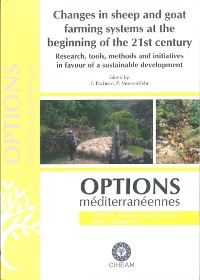| Article précédent | p. 375-388 |
La méthode de l'analyse de groupe, un moyen de restitution des résultats de gestion des systèmes de production ovine et caprine
L'agent de développement, dont la mission principale consiste à apporter une aide à la décision aux éleveurs de sa zone d'activité dans le but d'améliorer leurs revenus, doit pouvoir identifier les systèmes de production ovine ou caprine qu'ils exploitent. Puis, il doit analyser leurs résultats techniques et économiques en fonction de leurs environnements agro-socio-économiques, pour établir un diagnostic permettant de détecter les points faibles à améliorer. La méthode de groupe, grâce à la constitution d'un échantillon d'exploitations utilisant des systèmes de production ayant des caractéristiques proches et tenant compte des potentialités naturelles, économiques et sociales, permet de sélectionner des indicateurs technico-économiques élaborés à partir de la mise en relation de données à expliquer avec d'autres variables significatives. Ces indicateurs peuvent ainsi servir de base à des analyses comparatives. L'utilisation de cette méthode, dans une première approche, contribue à la découverte des potentialités des systèmes de production ovine et caprine de la zone d'activité de l'agent de développement. Puis d'une façon plus détaillée, cette méthode va autoriser des comparaisons entre les résultats des exploitations composant le groupe. La présentation de leurs différences se révèle très révélatrice pour les éleveurs soucieux de disposer d'indicateurs de marges de progrès qui leurs soient accessibles. Cette méthode exige une grande rigueur dans le choix des exploitations et la constitution du groupe, notamment sa taille et son homogénéité, mais aussi dans l'interprétation des liaisons entre indicateurs pour expliquer les variations de résultats entre systèmes de production.
The tasks of development officers are mainly to provide help to farmers for reaching decisions concerning the improvement of their income. With this target, they must identify the various systems of sheep and goat productions. Then, they must analyze their technical and economic results according to their agro-socio-economic environment, to establish a diagnosis allowing to identify the weak points to improve. The group method needs the setting up of a sample of farms with production systems presenting close features and taking into account their natural, economic and social potentialities. It allows to select the technical-economic indicators from the links between variables to be explained and variables giving explanations. Thus they can be used for comparative analyses. In a first approach, the use of this method, contributes to emphasize the potentialities of the sheep and goat production systems of the development agent's area. In a more detailed way, this method ensures interesting comparisons between the results between farms and between systems of production in this group. The presentation of their differences is very demonstrative for the farmers asking indicators which show up the extend of possible improvement. This method requires a large rigorousness in the farm choice and the establishment of the group, notably concerning its size and its homogeneity, but also analyzes the links between indicators to be explained and the different results between the production systems.
- [ Afficher ]
- [ Télécharger ]
- [ Exporter la citation ]
Vous pouvez télécharger la citation au format :
- [ Imprimer ]
-
Mots-clés
AIDE A LA DECISION, CAPRIN, INDICATEUR, METHODE, OVIN, RESULTAT DE L'EXPLOITATION AGRICOLE, SYSTEME D'EXPLOITATION AGRICOLECiter cet article
Toussaint G.-C. La méthode de l'analyse de groupe, un moyen de restitution des résultats de gestion des systèmes de production ovine et caprine. In : Pacheco F. (ed.), Morand-Fehr P. (ed.). Changes in sheep and goat farming systems at the beginning of the 21st century : research, tools, methods and initiatives in favour of a sustainable development . Zaragoza : CIHEAM / DRAP-Norte / FAO, 2009. p. 375-388. (Options Méditerranéennes : Série A. Séminaires Méditerranéens; n. 91). Proceedings of the Seminar of the Subnetwork on Production Systems of the FAO-CIHEAM Network for Research and Development in Sheep and Goats, 2007/11/15-17, Ponte de Lima (Portugal). http://om.ciheam.org/om/pdf/a91/00801167.pdf



